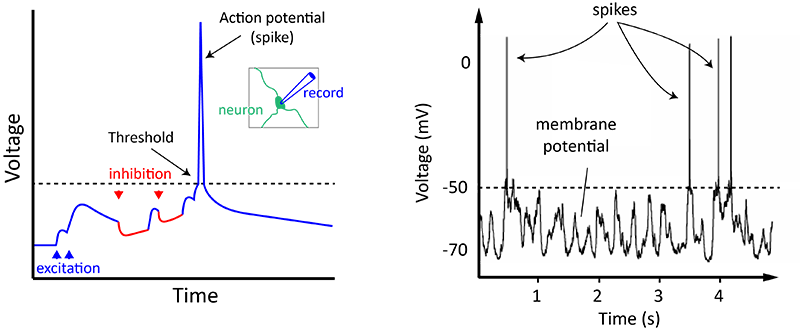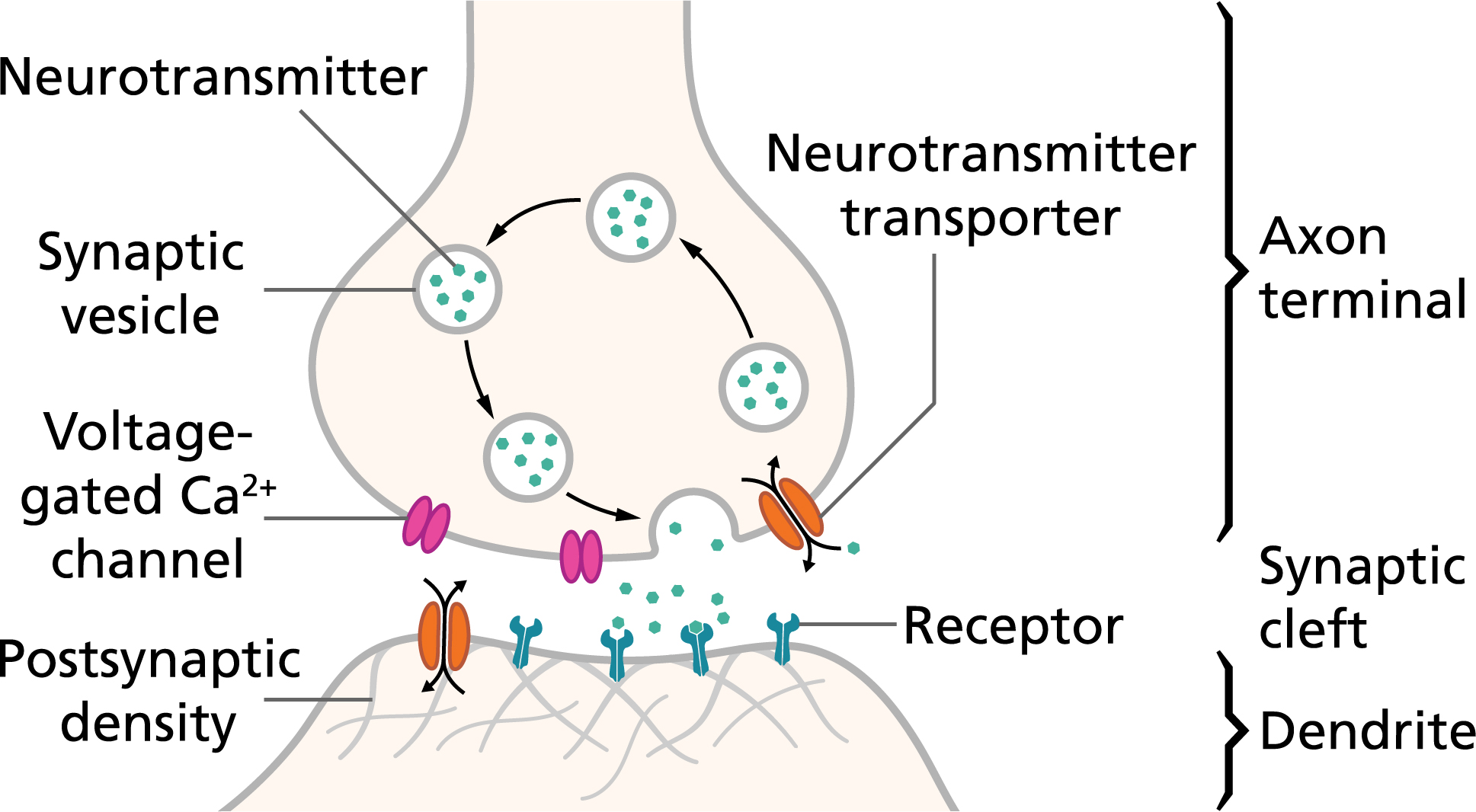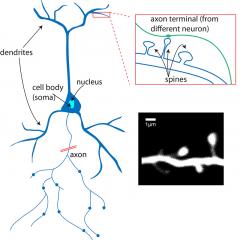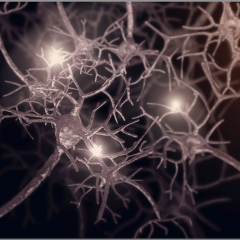Action potentials and synapses
Key facts: action potential and synapses
- Neurons communicate with each other via electrical events called ‘action potentials’ and chemical neurotransmitters.
- At the junction between two neurons (synapse), an action potential causes neuron A to release a chemical neurotransmitter.
- The neurotransmitter can either help (excite) or hinder (inhibit) neuron B from firing its own action potential.
- In an intact brain, the balance of hundreds of excitatory and inhibitory inputs to a neuron determines whether an action potential will result.
Neurons are essentially electrical devices. There are many channels sitting in the cell membrane (the boundary between a cell’s inside and outside) that allow positive or negative ions to flow into and out of the cell.
Normally, the inside of the cell is more negative than the outside; neuroscientists say that the inside is around -70 mV with respect to the outside, or that the cell’s resting membrane potential is -70 mV.
This membrane potential isn’t static. It’s constantly going up and down, depending mostly on the inputs coming from the axons of other neurons. Some inputs make the neuron’s membrane potential become more positive (or less negative, e.g. from -70 mV to -65 mV), and others do the opposite.
These are respectively termed excitatory and inhibitory inputs, as they promote or inhibit the generation of action potentials (the reason some inputs are excitatory and others inhibitory is that different types of neuron release different neurotransmitters; the neurotransmitter used by a neuron determines its effect).
Action potentials are the fundamental units of communication between neurons and occur when the sum total of all of the excitatory and inhibitory inputs makes the neuron’s membrane potential reach around -50 mV (see diagram), a value called the action potential threshold.
Neuroscientists often refer to action potentials as ‘spikes’, or say a neuron has ‘fired a spike’ or ‘spiked’. The term is a reference to the shape of an action potential as recorded using sensitive electrical equipment.

A neuron spikes when a combination of all the excitation and inhibition it receives makes it reach threshold. On the right is an example from an actual neuron in the mouse's cortex. (Image: Alan Woodruff / QBI)
Synapses: how neurons communicate with each other
Neurons talk to each other across synapses. When an action potential reaches the presynaptic terminal, it causes neurotransmitter to be released from the neuron into the synaptic cleft, a 20–40nm gap between the presynaptic axon terminal and the postsynaptic dendrite (often a spine).
After travelling across the synaptic cleft, the transmitter will attach to neurotransmitter receptors on the postsynaptic side, and depending on the neurotransmitter released (which is dependent on the type of neuron releasing it), particular positive (e.g. Na+, K+, Ca+) or negative ions (e.g. Cl-) will travel through channels that span the membrane.
Synapses can be thought of as converting an electrical signal (the action potential) into a chemical signal in the form of neurotransmitter release, and then, upon binding of the transmitter to the postsynaptic receptor, switching the signal back again into an electrical form, as charged ions flow into or out of the postsynaptic neuron.

An action potential, or spike, causes neurotransmitters to be released across the synaptic cleft, causing an electrical signal in the postsynaptic neuron. (Image: By Thomas Splettstoesser / CC BY-SA 4.0)
Video: Action potentials in neurons
Concepts and definitions
Axon – The long, thin structure in which action potentials are generated; the transmitting part of the neuron. After initiation, action potentials travel down axons to cause release of neurotransmitter.
Dendrite – The receiving part of the neuron. Dendrites receive synaptic inputs from axons, with the sum total of dendritic inputs determining whether the neuron will fire an action potential.
Spine – The small protrusions found on dendrites that are, for many synapses, the postsynaptic contact site.
Membrane potential – The electrical potential across the neuron's cell membrane, which arises due to different distributions of positively and negatively charged ions within and outside of the cell. The value inside of the cell is always stated relative to the outside: -70 mV means the inside is 70 mV more negative than the outside (which is given a value of 0 mV).
Action potential – Brief (~1 ms) electrical event typically generated in the axon that signals the neuron as 'active'. An action potential travels the length of the axon and causes release of neurotransmitter into the synapse. The action potential and consequent transmitter release allow the neuron to communicate with other neurons.
Neurotransmitter – A chemical released from a neuron following an action potential. The neurotransmitter travels across the synapse to excite or inhibit the target neuron. Different types of neurons use different neurotransmitters and therefore have different effects on their targets.
Synapse – The junction between the axon of one neuron and the dendrite of another, through which the two neurons communicate.
QBI research
QBI Laboratories working on neurons and neuronal communication: Professor Pankaj Sah
QBI Laboratories working on synapses: Dr Victor Anggono, Professor Frederic Meunier


